
Hitler's ideas concerning music and art shaped the cultural atmosphere and political policies for all of Germany. He decried the "degenerate" influence on German culture and stated his repugnance repeatedly. Any artist who did not fit into the ideal of Volk was not to be included. Volk was a key component to Hitler's ideal of Germany. It recalled a simple, pastoral life, meaning "folk and folkdom." True art as defined by Hitler was linked with the country life, with health, and with the Aryan race.
In 1933, three months after being appointed chancellor of Germany, Hitler issued the Law for the Cleansing of the Civil Service, declaring that any employee who was not of Aryan blood was to be fired. He also established the Reichskammern (Reich Chambers, or government departments) with Joseph Goebbels as minister. Artists and musicians who did not or could not become members were forbidden to work in their profession. Professors and art teachers who were Jewish or suspected sympathizers were dismissed from their posts. Many of those who did not flee the country were sent to ghettos and concentration camps. The Bauhaus, an internationally renowned architectural school, was closed.
- Ghetto and Camp Art. The record left by ghetto dwellers, camp internees, and displaced persons allows people to get a glimpse of life and death under Hitler.
- Nazi Approved Art. Art was considered to be one of the most important elements to strengthening the Third Reich and purifying the nation.
- Degenerate (Entartete) Art. By 1933, terms like "Jewish" "Degenerate" and "Bolshevik" were in common use to describe all art which did not fit the Nazi ideal.
- Art in Response to the Holocaust. The memory of the Holocaust has inspired people from all walks of life to create various art forms to express their feelings about this terrible period in history.
- Teacher Resources. Here you will find lesson plans and other resources for the study of the Holocaust through art.
| Ghettos & Camps | Reich Art | "Degenerate" Art | Response | Teacher Resources | 
A Teacher's Guide to the Holocaust
Produced by the Florida Center for Instructional Technology,
College of Education, University of South Florida © 1997-2013.